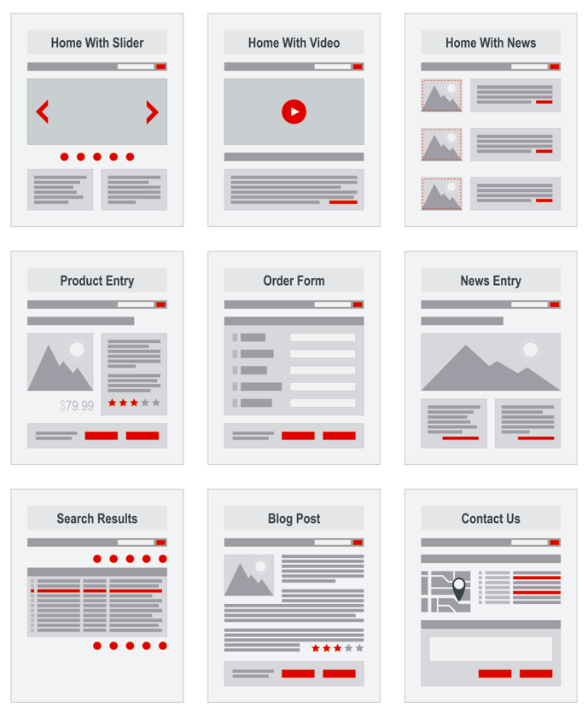
This article is part of our “Business Startup Guide” – a curated list of our articles that will get you up and running in no time!
Time is of the essence when it comes to getting your website up and running. If you want to snag your share of the market, you must act quickly. Today, creating a website isn’t something you should probably do, it’s something you must do. Whether you do it yourself—the affordable option—or outsource the design and build to a freelancer or agency, it’s still worth understanding the key steps that are involved in the process.
If you don’t already have some sort of online presence, you need to act quickly. You are losing out to the competition. Consider your website your online storefront. Even a simple storefront is better than no storefront. At least this way people will be able to find you.
This isn’t to say you should haphazardly piece together a site you’re not proud of.
The first lesson: never sacrifice quality. Quality is everything in the internet marketing game. And your website is just that – a part of your marketing strategy but also, a business asset. You don’t cut corners on your strategy documents, why would you do it on your website?
Quality, however, doesn’t necessarily equate to something complex. The bells and whistles can wait as you work to quickly create and launch your website. Your website design should be simple, and its focus should be on first conveying high-quality information that will gain attention and traffic.
Here’s how to get it done:
1. Choose your domain name
Choosing a proper domain name is like naming a baby. It needs to fit. Name your domain after the name of your business, so people can easily find it.
If you choose a domain name such as “www.welovecupcakes.com,” but your business name is Cupcake Kitchen, it won’t bring people to your site as easily as it could. Make things as effortless for your potential and existing customers as possible, beginning with the domain name.
What if the domain name you want is already taken?
You have two options in this scenario:
- You can try adding another word to the domain name, such as the city in which your business is located. Using the Cupcake Kitchen example, you could try “www.cupcakekitchenseattle.com,” adding Seattle to the end of the business name.
- Contact the individual currently in charge of the domain you want. He or she may be willing to sell it, but it will likely be more expensive than purchasing a new domain that is already available.
Should you use a generic domain name?
Many people think generic domain names, like www.cupcakes.com, are beneficial, but this typically isn’t the case for a startup. Opt for the best reflection of your business name, not the most generic term. Your customers are looking for you, not for generic information about cupcakes.
How long should a domain name be?
It can be up to 67 characters, but that doesn’t mean that it should be that long. A short domain name can be effective if it’s easy to remember and not just a few unrelated letters crammed together. A long name can be effective if it’s easy to remember and direct.
Additionally, be careful when using hyphens, changing a word to plural, or adding an article such as “a” or “the” before your domain name. If extra words aren’t part of the title of your business, it’s probably best to exclude them. People will forget to add extra words and hyphens when they attempt to find you.
If there’s another site called “www.cupcakekitchen.com” and you get “www.cupcake-kitchen.com,” then chances are you’re going to be sending your competitor a lot of traffic. Always be conscientious of your customers and respectful of their time. They will get frustrated if it’s too hard to find your website.
To recap, always go with what is easiest for your customers to remember. And always steer them away from your competitors, if possible, by choosing a domain name that is directly reflective of your business.
 Editor’s warning: when choosing a domain name, be careful to look at how people could interpret it: www.teacherstalk.com (Teachers Talk), could just as easily be read or interpreted as Teacher Stalk. Not what you were going for. Be on high alert!
Editor’s warning: when choosing a domain name, be careful to look at how people could interpret it: www.teacherstalk.com (Teachers Talk), could just as easily be read or interpreted as Teacher Stalk. Not what you were going for. Be on high alert!
2. Find a hosting company
After you secure a proper domain name, the next step is to figure out how you’re going to show it off. A website host will connect your site to the internet. Think of your hosting company like a hard drive for your site. It’s where all the information is stored. If the hosting falls through, no website. Pick a reliable company.
Consider the following three types of website hosts:
- Individual or “shared hosting” — This is the most affordable plan, and it’s typically limited to one domain. It may also come with some restrictive features, such as limited bandwidth, data storage, or other features. These plans share space on hosting servers with other webmasters and are usually the best option for a small, first website. Eventually, once you move into the realm of thousands of visitors and the potential of making online transactions, you might want to consider a dedicated server.
- Dedicated Servers — These plans are more expensive and grant a website its own server. Oftentimes, it’s necessary to upgrade to a dedicated server after having been successful and experienced growth on an individual plan. If you have plans for growth but begin with a shared hosting plan, be sure to choose a server that can transition your site to a dedicated server when you’re ready.
- Reseller Accounts — These accounts allow for multiple individual plans within a single account. If you’re planning to run several small sites, this is an appropriate option for you.
Do your research before jumping into a hosting plan. Look for a plan that offers customer support, has been positively reviewed by other users, offers enough space for your site to properly function, and can support a blog. Yes, you should have a blog.
 Editors note: Some of the most popular hosting companies or the companies with the biggest market share, include:
Editors note: Some of the most popular hosting companies or the companies with the biggest market share, include:
- Amazon AWS
- CloudFlare Hosting
- GoDaddy Hosting
- Unified Layer
- Rackspace
- Internetivo (this was an addition from us, Internetivo author)
3. Map out the site layout
 Now, it’s time to create your site. Whether you hire a professional or DIY, it’s important to devise a plan for taking customers through your site.
Now, it’s time to create your site. Whether you hire a professional or DIY, it’s important to devise a plan for taking customers through your site.
At this time you’re going to be hearing the word CMS quite a lot. CMS stands for content management system. This is the front-facing system or dashboard that you will use to update the content on your site. Here you will add images, create new pages, and create new blog posts.
Before you worry too much about the right CMS—this is often dictated by the hosting company you choose, or the company that builds your site—spend some time working out the exact pages you need to include.
What pages you need on your website will depend on your business and your specific industry. In addition to the homepage, you will need an “About Us” page and a contact page. Beyond this, it truly depends on your product. Think of the sites you like best and go from there.
Carefully consider how a visitor would ideally progress through your website. In the web world, we call this the “user journey.” Make sure the information he or she needs will be visible at the appropriate times. Be sure your contact information is always readily available and that the blog (if you have one) is easily found. We’ll go into blogging in more depth later but for the moment, if you have the ability to put words to paper, you should have one. It’s a great way to showcase your expertise and to give your customers or potential customers insight into your business. It will also help you stand out from the crowd.
Once you decide on all your pages, write a list of the page names and then try to put them in groups for your navigation. We call this the sitemap.
Now have someone else look it over, or if you’ve built it, give it a try. If every person that tries it does something wildly different or has trouble finding something, you need to change things. Be as human and as user-friendly as possible.
4. Bow to your king: content
Quality content is the king of the internet. If this is the first time you’ve heard that, it surely won’t be the last. If you want to make a positive impression on your website visitors, you must recognize the value of content marketing. It is the new SEO and its importance cannot be overstated.
As you populate your website with worthwhile content, you will gain readers, establish yourself as an industry thought leader, and gain more clients.
And as you gain more attention and grow as a business, your website ranking will improve, which will also lead to more sales and greater exposure.
This is the power that comes with a well-maintained, high-quality website that produces top-notch content. The rest of the steps in this list will focus on your content—it’s that important.
If you know nothing about content marketing, take a look at sites like Copyblogger and the Content Marketing Institute. They’re the big players in the field. Even sites that focus on SEO and online marketing, like Moz and KISSMetrics, often cover this topic in depth.
5. Realize the power of the “how”
Explaining “how to” do something is one of the best ways to grab someone’s attention. If people are interested in learning, they will listen if you present information the right way.
Well-planned “how-to” guides like this one give readers valuable information and position your business as a respected source of knowledge. Once you earn a reputation as an expert in your industry, your reach will grow exponentially.
 Editors Note: Consider those areas customers always ask questions about. You could even use Google’s auto-predict feature to see what people are typing in. Just start typing your sentence and you’ll be presented with a number of suggestions. This is quick and dirty SEO based on demand.
Editors Note: Consider those areas customers always ask questions about. You could even use Google’s auto-predict feature to see what people are typing in. Just start typing your sentence and you’ll be presented with a number of suggestions. This is quick and dirty SEO based on demand.

6. Become one with blogging
An active blog is a vital component of a successful website. If you want to rise to the top of the search engine result pages, it’s imperative that you publish quality blog posts.
Does this mean you have to write? Not necessarily. If writing well isn’t in your wheelhouse, find someone on your staff who can do it. You can also hire a writing service to do the writing for you, or you can do the writing yourself and opt to have it professionally edited.
Your blog represents your brand. Be sure to create original content—plagiarism is highly penalized—and ensure there are no typos or grammatical errors.
The beauty of a blog is that it can be anything you want it to be, as long as it informs your readers and is an accurate reflection of your business. For example, DrSnooze, a mattress company, recently wrote a blog post about how side-sleepers should choose a mattress. A topic like that can be great for answering customer questions.
Your blog can take on a friendly tone—most do—and it can be a place to post different ideas about what’s going on in your industry. Blogs can cover recent industry news, updates to your business, information about new products, and virtually anything your readers would want to read about.
Your blog is your business’s personal place to start conversations, brainstorm information, and process new thoughts and ideas.
To get started with creating relevant content for your blog, consider the following:
- Bring something new to the conversation. Don’t rehash old information. Your customers will appreciate your fresh take on an old topic. Aim to bring something new to the conversation and dissect information in an innovative way.
- Write to your audience. If you haven’t figured out exactly who you’re targeting, now is the time to do so. Know your audience and gear your content toward them.
- Create a list of industry statistics or news. People like to be in “the know.” If you become your customers’ source for relevant information, you will earn their trust.
- Blog about a controversial topic in your industry. As long as you do not alienate any members of your audience, you can use your blog as a space to discuss the controversy in your industry. It will engage your readers and position you as a credible source of knowledge.
- Showcase infographics and visual media. Your blog is the perfect place to display impressive visuals. Graphic media such as infographics and videos can be placed on your blog for eye-pleasing visuals. In internet marketing today, there is much more to content than just words. Meaningful conversations are often provoked through stunning media. Use sites like visual.ly and canva to create beautiful images for free.
7. Display your knowledge with articles
Articles are a bit different than blogs, although some people use the terms interchangeably. Articles tend to be longer than blogs, and more formal. While blogs are often experimental and act as brainstorms that often wrestle with new ideas, articles should always contain thoroughly researched information.
The articles on your website should:
- Contain informed opinions and researched information
- Be tailored to a specific target audience more so than a blog
- Offer depth and statistics if available
- Be more formal and offer niche details and information
- Sometimes be organized in a website’s library instead of on the blog
8. Expose your abilities through testimonials
You put a great deal of effort into your business, and your satisfied customers know how remarkable it is. So what’s the best way to let your potential customers in on this information?
Testimonials.

They serve as a trust-building showcase of your fine products and services. Include testimonials on your website to show potential new customers what you’re capable of. This is huge for new businesses. Most people haven’t heard of you yet and want some social proof that you are who you say you are. This is especially important if you sell products online.
Bonus: When doing everything, consider the user experience.
As you prepare to launch your first website, remember to consider the user experience before anything else. Don’t write your content for a search engine and stuff keywords everywhere; write so people can become engaged with your business or product. Don’t have video auto-play, no matter how cool you think they are. You want people to return to your site, but they’re not going to if they have to exit out of a video every time. Think about the user experience in absolutely every choice you make.
Opt to engage visitors with quality content, appropriately showcase your offerings, and keep the site’s content simple and easily digestible.
Creating a website can be a daunting task, but focus on the content without getting too fancy and you’ll make a great site in no time.
@Credit: Bplans

